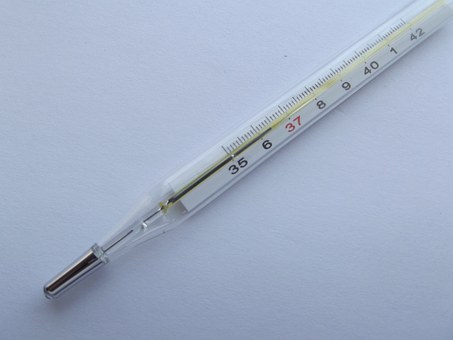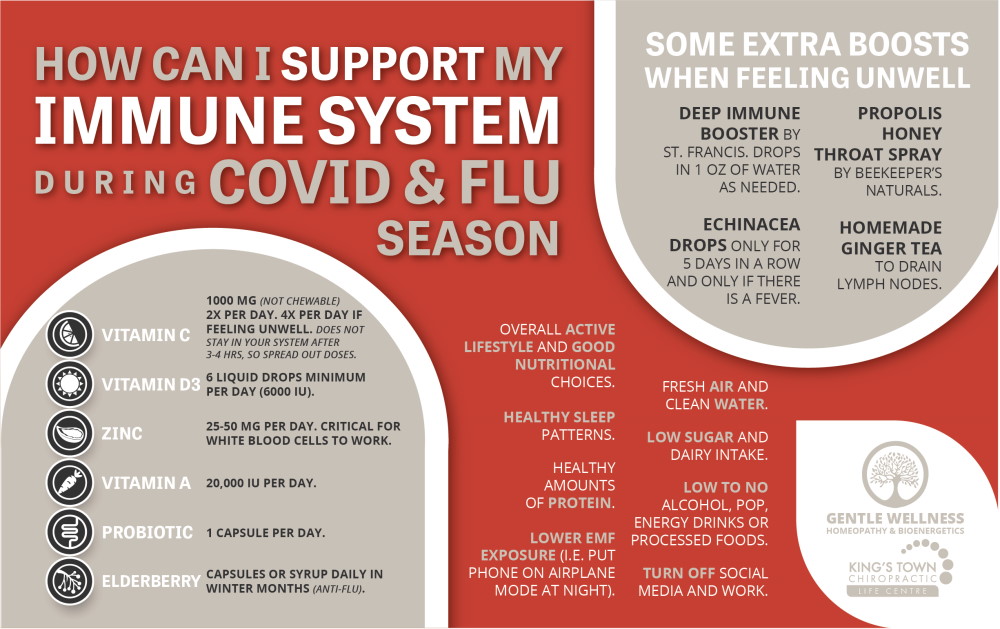
Fevers are a part of an extraordinary and intricate healing process; they are usually an indication of increased activity from the immune system. Our defense system uses a fever as a stimulus to destroy invading organisms and promote health. Many times, at the first sign of fever we try to lower or extinguish it with medicine (from a drug store or herbal supply) assuming it is a sickness that needs to be immediately addressed. Actually, it is only a sign from our body communicating with us that it is overheated (i.e. too long in the sun or sitting in a hot car) or that there is a possible underlying infection that it is attempting to remedy. Although a fever signals that a battle might be going on in the body, the fever is fighting for, not against, the person.
Fevers can be scary, especially for parents of young children. The best education a parent can receive is to learn when to take action and when to let a fever run its course. Below are some helpful facts to educate and empower you; trust your instincts and believe in the body’s natural defense system. As you gain confidence with your understanding of how to respond to a fever, you will find that many fears or anxieties are eased, and you will feel more in control of the situation, because when needed, you will have the understanding and homeopathic remedies available.
When combating an infection the best decision is to boost the body’s own defenses with good nutrition, rest, low stimulation and homeopathic medicines if required.
Important facts to know
- Everyone has their own internal regulation of body temperature. The average is 37 °C (plus or minus 0.6°C) or 98.6°F (plus or minus 1°F)
- A child’s temperature will tend to be lower in the morning and will naturally rise throughout the day with excitement, activity and exercise. It is normal for your child to have an elevated temperature later in the day; it does not necessarily indicate a fever.
- Fever is not an illness but it is a mechanism that has many beneficial effects in fighting infection. Fever retards the growth and reproduction of bacteria and viruses, enhances production of white blood cells (immune systems “attack” cells), and it aids in the body’s initial acute reaction to illness. The degree of fever does not always correlate with the severity of illness.
- A fever is defined by an oral temperature exceeding 38°C (100.4°F). They are usually self-limiting and short in duration. Every person will be unique in how they express their fever and what they can tolerate. Low grade fevers should be left alone without medical intervention. A higher fever, above 39 °C (102.5 °F), should be monitored and if you are concerned, call your Homeopath or Doctor if it is not resolved in 2-3 days.
- A fever by itself is not something to feel panicked about. Look at the child more than you look at the thermometer.
The questions to ask are:- How does the child look?
- How are they behaving?
- How are they sleeping?
- The American Academy of Pediatrics voiced concerns in a 2011 study, concluding that parents need to understand that the fever itself is not endangering to a healthy child. It’s actually beneficial, and the primary goal of treatment should be to improve comfort rather than lowering body temperature alone. They concluded that parents and healthcare providers should be clearly monitoring the child and watching for signs of serious illness (total body picture) versus being focused on maintaining normal body temperature.
- If the child is displaying a mild fever, some common sense treatments are:
- Don’t overdress the child
- Don’t layer them in blankets
- Increase fluids (without sugar), because they will lose fluids quicker with a fever
- Decrease household and extracurricular activity
- Allow your child time to be “under the weather”
- According to the National Institute for Health, brain damage from a fever generally will not occur unless the fever is over 42 °C (107.6 °F). Untreated fevers caused by infection will seldom go over 40.5 °C (105 °F) unless the child is overdressed or trapped in a hot place.
- When to visit the Doctor or Homeopath?
- Your child is younger than 2 to 4 months old and has a fever.
- Your child is lethargic, unresponsive, refuses to eat, has a rash, or is having difficulty breathing.
- You observe signs of dehydration in a young child, such as a dry mouth, a sunken soft spot, or significantly fewer wet diapers.
- An older child may complain of a severe, sudden headache and have mental changes, neck or back stiffness, or rashes.
- Your child’s fever lasts more than a few days
- Your child is experiencing an ear infection or other sign’s of infection that need to be monitored or treated.
- Your child experiences a febrile seizure.
- What is a Febrile Seizure?
- A febrile seizure is a relatively common and harmless side effect of fevers in young children.
- They do not cause permanent damage.
- It’s a full-body seizure where your child may be unresponsive, look strange, twitch, stiffen or roll his eyes.
- Remain calm and move your child to a safe place where he can’t hurt himself. Do not put anything in his mouth. Febrile seizures usually last less than one minute, but can last up to 15 minutes.
- Follow up with your Doctor or Homeopath for all febrile seizures.
- Having a Febrile seizure does not mean your child has epilepsy.
At Home, Homeopathic Alternatives
If you or your child is experiencing a fever with significant discomfort, difficulty in maintaining hydration, disturbed sleep or a high fever that is of concern to you, please consider the Homeopathic medicines below. When in doubt, or if none of these apply, please call a qualified Homeopathic Practitioner for guidance.
Directions:
Fevers above 39 °C (102.5 F) tend to be intense, so a 200c potency of the medicine is appropriate.
Give 1 dose (2 pellets) and watch/wait.
- If the fever lowers (not necessarily disappears) and the patient is more comfortable, then allow the body to continue to heal independently.
- If the medicine helped, but the fever relapses, re-dose as necessary.
- With high fevers that are sudden and violent in nature you may initially need to repeat often (every 15-30 min).
- If the fever does not respond to the initial dose, repeat within the half hour. After 3 doses, if there is no response, then you may want to consider a different homeopathic medicine.
Remember, the goal is not to extinguish the fever, but to allow the adult or child to be more comfortable and to aid the body in its overall efforts to combat infection. If an intense and violent fever can not be calmed and the patient is experiencing other more serious symptoms, please contact a qualified Doctor immediately.
Aconite
- Sudden, violent fever
- Complaints come on after exposure to dry/cold weather
- May appear after a fright, shock
- Skin dry and burning
- Fever and chills alternate
- Intense thirst
- Restless, anxious
- In high fever, mentally alert but frightened (opp. to belladonna)
- Pupils are constricted (dilated pupils = Belladonna)
- Face is red, hot, flushed, swollen…BUT upon rising faces become deathly pale
- Worse: evening, before midnight
Belladonna
- Intense, high fever
- Fast, sudden – comes on suddenly and goes suddenly
- Dry , Hot, radiating fever, little perspiration
- Hot head with cool body OR hot head and body with cold hands / feet
- Delirium, hallucinations, dazed look, “stupor”
- Red, flushed face
- Has a dry mouth but doesn’t want to drink (thirst less)
- Dilated pupils
- Worse: 3pm
- Throbbing / pulsating sensations (i.e. pulsating headache or a hard forceful pulse)
- Right sided symptoms
Arsenicum
- Heat of the face with a chilled body
- Heat and chill alternate
- Thirsty for small sips
- Rapid collapse and exhaustion (weakness out of proportion to the degree of fever/illness)
- Better: bundled up and warm except for head, which is better with cold
- Worse: cold air and cold drinks; after midnight
- Anxious, fearful, agitated, and very restless
Bryonia
- Lazy onset of a high fever
- One sided heat
- Shivery and sweaty
- Thirsty for large amounts of cold water
- Severe headache
- Flushed face
- Worse: least motion, anger, evenings (9pm)
- Better: lying still
- Irritable and wants to be quiet and left alone
Chamomilla
- Fever especially in young children
- Unbearable, long lasting heat; often without a chill
- Lots of crying, shrieking, temper tantrums, whines
- Irritable, excited, doesn’t know what they want
- Fever in relation to teething
- VERY oversensitive to pain
- Child wants to be held and carried, always moving
- One cheek red/hot, the other cheek pale
- Sleeplessness
- Fever worse: 9am but generally worse: 9pm-12am
- Very thirsty
China
- Chills and severe shaking give way to high fever. Followed by profuse sweating
- Very thirsty
- Prostrate, weakness, fatigue especially after long fever
- Worse after loss of fluids i.e. vomiting, diarrhea
- Sensation of prickling all over body with heat/fever
- Worse: motion, drafts, afternoon and evenings
- Desires to be uncovered but it brings on the chill
- Skin sensitive to touch
- Easily disturbed sleep, irritable
- Abdominal pain during fever
Gelsemium
- Fever with lots of shivering and weakness
- Chills run up and down the spine
- Sleepiness, weakness, trembling
- Thirst less when sick
- Fever is low but ongoing for several days
- Flushed face, hot head
- Heavy and droopy eyelids; heavy limbs
- Headache worse least movement, light or noise
- Wants to be left alone
- Mentally: worries and anticipation concerns “what if…”
Sulphur
- Especially for fevers that have slow onset, are long lasting or not responding to treatment
- Fever especially at night with heavy perspiration (moist heat)
- Entire body radiating heat, including burning hot feet
- Flushed face
- Thirsty for cold drinks
- Better: being uncovered
- Mentally quite happy
This material is for information purposes only and does not replace medical advice from your MD.
Resources used for this article:
- Journal of American Academy of Pediatrics – http://pediatrics.aappublications.org/content/127/3/580.full.pdf
- Healthy Children.Org – http://www.healthychildren.org
- New York Medical Journal: Parental Perceptions of Fever in Children – http://newyorkmedicaljournal.org/index.php/articles/parental_perceptions_of_fever_in_children_a_qualitative_approach
- MedLine Plus: Fevers http://www.nlm.nih.gov/medlineplus/ency/article/003090.htm
- Yale Medical Group: When your Child has a Fever – http://www.yalemedicalgroup.org/stw/Page.asp?PageID=STW000643
- Gibson, Dr DM, First Aid Homeopathy; Scotland, 2005
- Morrison, Roger; Desktop Companion to physical pathology; California, 1998
- Herring, C., Guiding Symptoms of our Materia Medica

